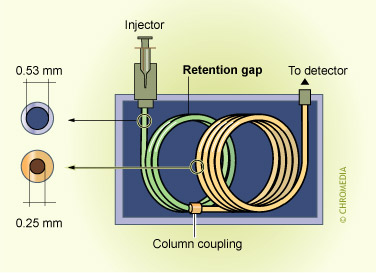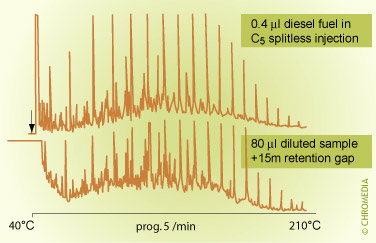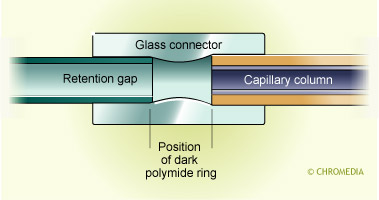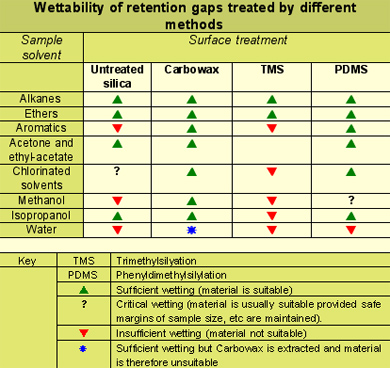The retention gap
- Page ID
- 61183
In order to fully take advantage of the solvent effect during on-column and splitless injection, it is essential that the sample will form a continuous film on the stationary phase. This, however, is difficult to achieve for large injection volumes. Here the liquid film will often be fragmented.
During on-column injection, problems can occur if the liquid sample zone is fragmented due to the size of the sample or the technique employed during injection. These problems can be largely avoided by using a retention gap.
Position of a retention gap

A retention gap consists of a length of uncoated, deactivated fused silica capillary tubing, connected between the on-column injector and the capillary column itself. The retention gap is normally of the same diameter as the capillary column, but its length can vary between 1 m and 5 m depending on the sample size. A good average length for most purposes would be 2 m, although lengths as high as 100 m have been reported for extra large sample volumes.
As the retention gap contains no stationary phase, sample components are not retained by the retention gap other than by the low initial oven temperature. They will be rapidly flushed to the analytical column as soon as the oven temperature increases.
Sample molecules can only reach the capillary column in the vapour phase. This means that the effects of any fragmentation of the original sample zone will be cancelled out by vaporization of the sample as it is transferred from the retention gap to the stationary phase at the beginning of the analytical column. The compounds evaporating from the retention gap will be trapped within the first millimetres of the coated analytical column. This results in a highly efficient refocussing.
Reconcentration power using retention gaps

Advantages of using retention gaps
Features and advantages of retention gaps:
- No peak splitting
- Prolonging the lifetime of analytical columns
- High-boiling compounds or particulate contaminants of the sample will remain in the retention gap and will not reach the column. The accumulated residue can be removed periodically by cutting of a piece of the front end of the retention gap.
- Non chemically-bonded columns can be used in conjunction with splitless or on-column injection.
- Simple coupling to an on-column injector for use of autosamplers
- Use of standard needles/syringes for automated on-column injection
- On-column injection possible with narrow-bore columns: For example, a 0.32 mm or 0.53 mm ID retention gap can be used for on-column injection with a smaller diameter column. Care must be taken however because the extra-column band broadening effect of increasing retention gap diameter is far more critical than that of increasing length. Moreover, the connector used should have a very low dead volume.
- Injection of (very) large liquid sample volumes
Coupling a 0.53 mm ID retention gap to the column is normally carried out using a glass press fit or quickfit connector. With this type of retention gap, an autosampler for on-column injection can be used in combination with narrow and medium bore analytical columns.
Quick seal connector

A retention gap is recommended even in conjunction with a bonded-phase column as it minimizes the chances of peak distortion due to smearing, flooding or film non-uniformity. The condensed solvent film is known as the flooded zone and occupies a region of 20-30 cm per microlitre of sample injected, although this will depend on the diameter of the retention gap and the type of deactivation.
The length of the retention gap is usually 2 - 5 m in length depending on the length of the analytical column and the sample size, and its diameter is normally the same or larger as that of the column.
Although the retention gap does not contain any stationary phase it must be deactivated, to avoid peak tailing effects, and it must be wettable by the proposed sample solvent. This is accomplished by adapting the deactivation process to produce retention gaps of various polarities, and these are available from commercial suppliers.


